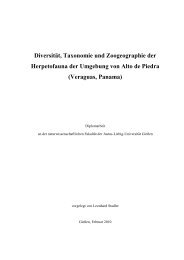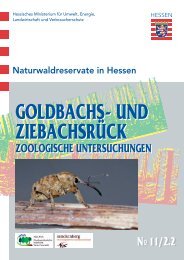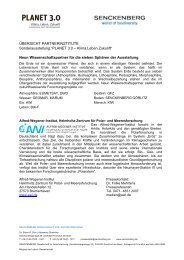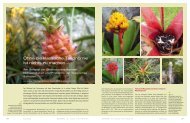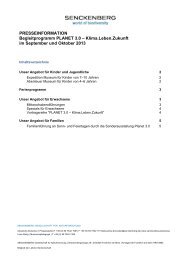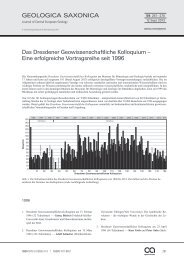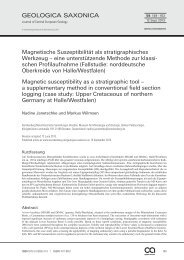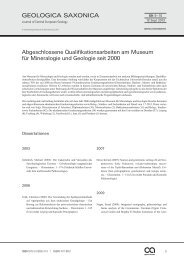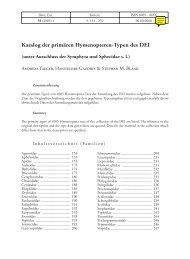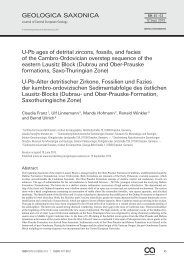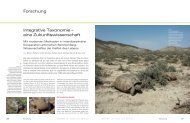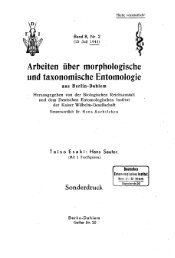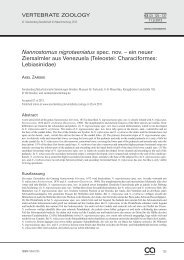pdf 4 MB - Senckenberg Museum
pdf 4 MB - Senckenberg Museum
pdf 4 MB - Senckenberg Museum
Create successful ePaper yourself
Turn your PDF publications into a flip-book with our unique Google optimized e-Paper software.
Arthropod Systematics & Phylogeny<br />
70 (2) 85 – 94 © <strong>Senckenberg</strong> Gesellschaft für Naturforschung, eISSN 1864-8312, 28.09.2012<br />
An extreme case of epitoky in an Australian Collembolon:<br />
Isotopenola perterrens sp.n. (Hexapoda: Collembola: Isotomidae)<br />
> Abstract<br />
PeneloPe Greenslade 1, * & Mikhail PotaPov 2<br />
1 Environmental Management, School of Science,<br />
Information Technology & Engineering, University of Ballarat,<br />
Ballarat, Victoria 3353, Australia<br />
[Pgreenslade@staff.ballarat.edu.au]<br />
2 Department of Zoology and Ecology, Moscow State Pedagogical University,<br />
Kibalchich str., 6, korp. 5, Moscow 129164, Russia<br />
[mpnk@orc.ru]<br />
* Corresponding author<br />
Received 11.viii.2011, accepted 19.iii.2012.<br />
Published online at www.arthropod-systematics.de on 28.ix.2012.<br />
Isotopenola perterrens sp.n. is described from a 40 year old Eucalyptus plantation in Victoria, Australia, and its occurrence<br />
in an adjacent site of remnant native vegetation is reported. Fully adult males are armed with numerous strong spine-like<br />
macrochaetae on lateral parts of head and body tergites and with fields of long bristles on latero-ventral and ventral areas of<br />
abdomen. Antennae of epitokous males are of normal shape but bear thickened chaetae. This is the second and most extreme<br />
case of epitoky recorded in the genus. The occurrence of sexual dimorphism, of which epitoky is a subset, is summarised for<br />
Australian Collembola. Environmental factors that appear to facilitate successful recolonisation of native fauna onto revegetated<br />
sites in Australia are proposed.<br />
> Key words<br />
Sexual dimorphism, revegetation, cyclomorphosis, ecomorphosis, reproductive cycle.<br />
1. Introduction<br />
The collembolan genus Isotopenola Potapov et al.<br />
(Isotomidae-Anurophorinae) was erected for a group<br />
of species from southern regions with habitus and<br />
some characters similar to the Eurasian genus Subisotoma<br />
Stach (PotaPov et al. 2009) and of similar<br />
size of up to 2 mm. It was differentiated from Subisotoma<br />
by the presence of secondary granulation on the<br />
sterna and two ventral setaceous fields, one on each<br />
side of the mid line of the sternum of the third abdominal<br />
segment (sf-III). Isotopenola is known only from<br />
the Southern Hemisphere. Four species were included<br />
by PotaPov et al. (2009) in the genus. Of these, three<br />
were from Australia, loftyensis (Womersley, 1934),<br />
australis (Womersley, 1934) and delicata Potapov et<br />
al., 2009; one was from southern India (Nilgiri Hills,<br />
85<br />
300 km SW Bangalore); and several probable species<br />
from New Zealand are not yet confirmed. One of these<br />
species, I. australis, exhibits sexual dimorphism.<br />
Species of Isotopenola are found widely in subhumid<br />
and humid temperate climatic zones of Australia<br />
from the Eyre and York Peninsulas in South Australia<br />
to the Mt Lofty Ranges, across south eastern Australia,<br />
Tasmania and north as far as Atherton Tableland<br />
in Queensland as well as a single record from arid regions<br />
(MacDonnell Ranges, Northern Territory). It is<br />
most frequent in Eucalyptus forest leaf litter, moss and<br />
native Poa grasslands in temperate climates. On even<br />
more humid, cooler sites, it is sometimes replaced by<br />
species of Cryptopygus Willem (Isotomidae-Anurophorinae).<br />
For example, on Mt Lamington, Queens-
86<br />
land, a species of Isotopenola is most abundant at 900<br />
m while a species of Cryptopygus is only found at the<br />
summit of 1100 m (Greenslade & KitchinG 2011).<br />
Here we describe a new species of Isotopenola, I.<br />
perterrens, from a forty year old Eucalyptus plantation<br />
in southern Victoria and a nearby site of remnant native<br />
vegetation. This species exhibits extreme epitoky<br />
in fully adult males. The term epitoky, first described<br />
by cassaGnau (1952, 1955, 1956, 1958), was coined<br />
for species in which certain specimens show marked<br />
morphological and some internal changes with season<br />
and/or weather, realised during moulting.<br />
2. Abbreviations and terminology<br />
Institutes<br />
MSPU Moscow State Pedagogical University<br />
SAMA South Australian <strong>Museum</strong> Adelaide<br />
Morphology<br />
A – E (Fig. 4) papillae on labial palp<br />
A – H (Fig. 5) ocelli<br />
Abd.I – VI abdominal segments I – VI<br />
Ant.1 – 4 antennal segments 1 – 4<br />
АО antennal organ on third antennal segment<br />
bms basal microsensillum / -sensilla<br />
d dens<br />
gen genital opening<br />
LM lateral macrochaetae<br />
lp lateral process<br />
LS large spines<br />
man manubrium<br />
ms microsensillum / -sensilla<br />
mu mucro<br />
PAO postantennal organ<br />
s sensillum / sensilla<br />
SS small spines<br />
sf-III ventral setaceous field<br />
t.ch. tenent tibiotarsal chaetae<br />
Th.I – III thoracic segments I – III<br />
u unguiculus<br />
U unguis<br />
Terminology for chaetotaxy used here is as follows: Ordinary<br />
chaetae are short, fine setae; they can be developed into short<br />
spines. Macrochaetae are longer chaetae and can be developed<br />
into bristles which are stronger and thicker, or further<br />
developed into strong spines also long. Sensilla (s) may be<br />
microsensilla and are constant and are fine, thin-walled setae.<br />
Greenslade & PotaPov: A new species of epitokous Collembola<br />
3. Results<br />
3.1. Description<br />
Isotopenola perterrens n.sp.<br />
Figs. 1 – 12<br />
Type material. Holotype, epitokous male: Australia, Victoria,<br />
Mt Helen, 40 year old Eucalyptus plantation, leaf litter,<br />
sticks, bark, moss, leg. P. Greenslade, 6.xii.2009, 37°38.840′S<br />
143°53.451′E, asl 502 m. – Paratypes: 8 specimens with same<br />
locality and date as holotype (3 epitokous); 7 specimens from<br />
the same locality, vii.2010, 37°37.810′S 143°53.45′E (none<br />
epitokous). – Deposition of holotype and 7 paratypes at SAMA,<br />
8 paratypes at MSPU.<br />
Type locality. Mt Helen, Ballarat, Victoria Australia.<br />
Adult and subadult males and females of the same size,<br />
1.5 – 1.8 mm. Colour blackish-blue, appendages paler.<br />
Body plump, with cryptopygy. Cuticle with small pits<br />
regularly scattered all over body. Lateral parts of head<br />
and thorax, intersegmental areas, the most part of venter<br />
with secondary granulation (Fig. 5). 8 ocelli 1 per<br />
side, G and H much smaller (half as long as others)<br />
and hardly visible. PAO widely elliptical, without constriction,<br />
1.2 – 1.8 × as long as ocellus diameter and<br />
0.4 – 0.7 × as long as Claw 3. Maxillary palp simple,<br />
4 sublobal chaetae present. Labrum with 2/554 chaetae.<br />
Labial palp with all papillae A – E present, papilla<br />
A with 1, B with 3 – 4 (variable), D with 4, E with 4<br />
guard chaetae, proximal chaetae 3 (Fig. 4). Basomedial<br />
field of labium with 4 chaetae. Ventral side of<br />
head with 4+4 post labial chaetae along ventral line<br />
(more rarely 5 or 6 on one side). Ant.1 with 16 – 21<br />
(normally 19 – 20) common chaetae, 2 bms (dorsal<br />
and ventral) and 2 ventral sensilla (s), Ant.2 with 3<br />
bms and 1 distal s, Ant.3 without bms and with 5 distal<br />
s, including one lateral in AO. Inner sensillum of<br />
AO clearly broadened, a little shorter than outer ones,<br />
additional sensilla absent. Ant.4 with numerous thin,<br />
differentiated sensilla, subapical organite very small,<br />
sometimes fully hidden in cuticular burrow, subapical<br />
microsensillum present.<br />
All terga with dense cover of uniform, long or short<br />
ordinary chaetae (Figs. 2, 5, 8, 9), macrochaetae absent<br />
except on epitokous males with uniformly short<br />
ordinary chaetae and macrochaetae, non-epitokous<br />
1 In Collembola this term does not refer to the median eyes as<br />
is common usage for other Arthropoda, but to groups of<br />
fused ommatidia of the modified compound eyes; see hoP-<br />
Kin (1997).
Arthropod Systematics & Phylogeny 70 (2)<br />
Figs. 1, 2. Isotopenola sp.n., epitokous male. 1: Distribution of spines and macrochaetae on body (groups of lateral spines = LS and<br />
lateral and ventral macrochaetae = LM are marked). 2: Dorsal chaetotaxy of Abd.III – V (the last segment is hidden under Abd.V).<br />
males and females with uniformly long ordinary chaetae.<br />
Dorsal axial chaetotaxy of Th.II – Abd.IV as 7 – 10,<br />
10 – 11/8 – 9,7 – 8,8 – 9,11 – 14. Tergal sensilla distinctly<br />
different from ordinary chaetae, short and slender,<br />
arranged in two irregular transverse rows, anterior and<br />
posterior (excluding lateral parts of Th.II, Th.III, and<br />
Abd.V), position and number variable. Total number<br />
of sensilla on Th.II – Abd.V 7 – 8,6 – 8/4 – 5(6),4 –<br />
5(6),4 – 6,7 – 9,ca.9 – 10 (Fig. 3). The number of tergal<br />
87<br />
microsensilla 11/111. Sternum of Th.III without chaetae.<br />
Unguis with or without small tooth (Figs. 6, 7).<br />
Unguiculus shorter than unguis (unguiculus : unguis<br />
= 0.40 – 0.55). Tibiotarsi 1 – 3 with many proximal<br />
chaetae, tibiotarsus 1 with 24 – 26, tibiotarsus 2 with<br />
26 – 28, tibiotarsus 3 with 33 – 37. Tibiotarsal tenent<br />
chaetae (t.ch.) 1, 2, 2, slightly clavate, longer than inner<br />
edge of unguis (Claw 3 : t.ch. = 0.7 – 0.8). Ven-<br />
1<br />
2
88<br />
4<br />
Greenslade & PotaPov: A new species of epitokous Collembola<br />
Figs. 3 – 7. Isotopenola sp.n., epitokous male. 3: Distribution of (macro)sensilla and microsensilla on body (area on abdomen de -<br />
void of sensilla is marked). 4: Labial palp (A – E – labial papillae). 5: Dorsal chaetotaxy of head (A – H – ocelli) and Th.I – II (sensillum<br />
positioned most laterally on Th.II is not shown). 6, 7: Apical part of leg 3 in female (6) and adult epitokous male (7).<br />
5<br />
3<br />
6<br />
7
Arthropod Systematics & Phylogeny 70 (2)<br />
8<br />
9 12<br />
11<br />
Figs. 8 – 12. Isotopenola sp.n. 8 – 10: Abd.I in epitokous male in ecdysis: old cuticle (8), new cuticle (9), area of tergite with “double”<br />
cuticle (10). 11: Mucrodens, lateral view. 12: Ventral chaetotaxy of Abd.III – V in epitokous male and furca (tenaculum not<br />
shown, submedial setaceous field marked).<br />
tral tube with 4+4 lateral and 4 – 7 posterior chaetae,<br />
normally 4 in distal transversal row. Tenaculum with<br />
4+4 teeth and one chaeta. Submedial fields on Abd.<br />
III sternum with 6 – 12 chaetae (sfIII), anterior part of<br />
furcal subcoxa with 9 – 15 chaetae (Fig. 12), posterior<br />
part with 14 – 18 chaetae. Manubrium without anterior<br />
chaetae, posterior face (Fig. 12) with 4 – 6 + 4 – 6 chaetae<br />
on laterobasal lobes. Dens with 1 anterior and 6<br />
posterior chaetae in position common for the genus.<br />
1 small basal posterior chaeta sometimes absent on<br />
one side. Mucro long, with 2 teeth (Fig. 11). Ratio of<br />
manubrium : dens : mucro = 4.1 – 5.9 : 3.1 – 4.6 : 1.<br />
Fully adult males that have a conspicuous ejaculatory<br />
duct are strongly modified, mainly with regard<br />
10<br />
89<br />
to chaetotaxy. They are covered with numerous short<br />
chaetae as is normal but also armed with spines and<br />
bristles (Figs. 2, 5, 8). Straight spines are scattered all<br />
over the body with two types distinguished, large (LS)<br />
and small (SS). Large spines predominate and are arranged<br />
mainly in lateral parts of head, Th.II, Th.III,<br />
and Abd.I – III, where they are grouped into dorsolateral<br />
“brushes” (Fig. 1). The spines positioned more<br />
laterally in brushes may be longer and slightly curved<br />
(Fig. 2). Abd.IV is more regularly and densely covered<br />
with these spines. Abd.V and posterior edge of Abd.IV<br />
bear small spines. Single small spines are sometimes<br />
present among the large ones on all other tergites and<br />
head. One specimen with small spines distributed on
90<br />
Greenslade & PotaPov: A new species of epitokous Collembola<br />
Fig. 13. Map showing location of type locality (plantation) and adjacent patch of remnant vegetation at Mt Helen.<br />
posterior half of Abd.IV was observed. Depending on<br />
specimen, the position and number of spines vary (often<br />
asymmetrically) but they maintain the general pattern<br />
of distribution described above. Ordinary chaetae<br />
of the body are short resulting in the chaetotaxy<br />
of epitokous males being strongly differentiated into<br />
thick, straight, large spines and short chaetae (Fig.<br />
8). This contrast is more striking on the thorax and<br />
anterior half of the abdomen. Lateral parts of Abd.<br />
IV and latero-ventral and ventral parts of Abd.II – VI<br />
bear long bristles arranged in groups (Figs. 1, 2). As<br />
these chaetae extend laterally the habitus of epitokous<br />
males appears to be more dorsoventrally flattened<br />
than in non-reproductive individuals. The unguiculus<br />
in epitokous males is somewhat shorter, i.e. ratio<br />
unguiculus : unguis = 0.37 – 0.44 in epitokous males<br />
and 0.5 – 0.54 in females and non-reproductive males<br />
(Figs. 6, 7). Chaetotaxy of females and non reproductive<br />
males is unmodified with numerous, both short<br />
and long, chaetae (as in fig. 97 in PotaPov et al. 2009)<br />
as is common for the genus.<br />
One male was observed in ecdysis from reproductive<br />
to non-reproductive instar exhibiting the transformation<br />
of strongly differentiated chaetotaxy with<br />
heavy spines to non-spiny, homogeneous “female”<br />
chaetotaxy (Figs. 8 – 10). This suggests that epitokous<br />
(reproductive) and non-epitokous (non-reproductive)<br />
stages are likely to alternate in the life cycle of the species.<br />
Modified males were found in December (summer),<br />
while non-reproductive females and males were<br />
observed in July (winter).<br />
An additional character that differs between the<br />
sexes is the presence of two thickened, apically truncate<br />
spurs on the third pair of legs in males. Truncate<br />
spurs are present on legs of many species of Anurophorinae;<br />
however, they are always less well developed<br />
and similar in both sexes, so not a sexually dimorphic<br />
character.
Arthropod Systematics & Phylogeny 70 (2)<br />
3.2. Distribution<br />
Currently known only from the type locality and from<br />
a nearby remnant vegetation site (50 m apart) in Victoria<br />
(Australia) (Fig. 13). However, there are possible<br />
14 15 16<br />
17<br />
19<br />
Figs. 14 – 20. Photographs of habitats at Ballarat where Isotopenola perterrens were found. 14 – 16: Type locality (plantation).<br />
17 – 20: Source area of remnant vegetation and part of the ground cover.<br />
91<br />
records from southern Victoria; these are unconfirmed<br />
as epitokous males were absent. Collections came<br />
from three sites carrying remnant vegetation in south<br />
eastern Victoria, all within 200 km of Ballarat, and<br />
were also made in autumn (March) but additionally in<br />
spring (August) (Greenslade et al. 2011).<br />
18<br />
20
92<br />
3.3. Diagnosis<br />
The new species belongs to the genus Isotopenola in<br />
having distinct secondary granulation on sterna and<br />
submedial setaceous fields ventrally on Abd.III.<br />
Many characters of the post labial area, labial palp,<br />
tibiotarsi (with abundant chaetae), first antennal segment<br />
and body tergites are shared with I. loftyensis,<br />
which is known from a range of sites in the southern<br />
Mt Lofty Ranges of South Australia (PotaPov et al.<br />
2009). The new species differs from the latter species<br />
in having fewer sensilla on body with half to two<br />
thirds fewer depending on tergite. Epitoky is unknown<br />
in I. loftyensis but fully adult males have not been collected.<br />
The second species of the genus with strongly<br />
modified reproductive males, I. australis, has a different<br />
type of epitoky. In this species the spines in males<br />
are weaker, denser and of subequal size. Reproductive<br />
females are also modified but less so; they also<br />
bear spines, but fewer and smaller ones (PotaPov et al.<br />
2009). The extent of epitoky in the genus Isotopenola<br />
is not yet understood and, as the phenomenon appears<br />
to be seasonally linked; collections throughout the<br />
year of other Australian and New Zealand species are<br />
needed.<br />
3.4. Ecology<br />
The plantation site at Mt Helen, south western Victoria<br />
(Fig. 13, 14 – 16), has a temperate climate with<br />
maximum temperatures of 21 – 24°C in summer and<br />
9 – 12°C in winter. Rainfall averages just over 700 mm<br />
p.a., mainly falling in winter, but prior to the collection<br />
of epitokous males in 2009, rainfall in five of the six<br />
previous years had been lower than the average. However,<br />
the drought had partially broken with a heavy<br />
rainfall in late spring of 2009 (November), two weeks<br />
before the collections of epitokous males of Isotopenola<br />
perterrens were made. Soils are poor, being ancient<br />
sea floor of Ordovician age. Prior to 1970, when the<br />
university moved to the site, the land had been grazed<br />
but not cropped and, in the early 1970s, a grove of Eucalyptus<br />
viminalis and Eucalyptus botryoides, both native<br />
to Victoria, was planted between the road and the<br />
university car park; several species of Acacia, some<br />
not local, were included as a fast growing overstorey.<br />
The plantation has never been harvested (Fig. 14). The<br />
Acacia shrubs have almost completely died out with<br />
the closure of the canopy. The ground cover consists<br />
of a thick layer of leaf litter, bark and other rotting<br />
timber; some patches of mosses are also present (Figs.<br />
Greenslade & PotaPov: A new species of epitokous Collembola<br />
14 – 16). Management is minimal and consists of spot<br />
spraying of weeds such as gorse, and cool, fuel reduction<br />
burning every 10 years in a mosaic pattern. The<br />
size of the plantation is 50 m by 200 m.<br />
Adjacent to the plantation type locality (50 m<br />
upslope), is a large patch of remnant native vegetation<br />
(Fig. 13, 17 – 20), 300 m by 200 m, with a native<br />
grassy understorey carrying mainly the local Eucalyptus<br />
obliqua. In early March 2012 (i.e. after acceptance<br />
of this manuscript for publication) epitokous I. perterrens<br />
were found in leaf litter of this site. It is most<br />
likely the source area for the I. perterrens population<br />
in the nearby plantation.<br />
Epitokous males were only found in summer (on<br />
the plantation: December) and in autumn (on the nearby<br />
remnant site: March) at Mt Helen. This is the same<br />
season as chimitova & PotaPov (2011) found epitokous<br />
males of Subisotoma stepposa in Russia, another<br />
species showing extreme modifications of sexually active<br />
and neutral males.<br />
In a survey of 20 revegetated, untreated or remnant<br />
vegetation sites in Victoria in 2010, unconfirmed<br />
I. perterrens were found in autumn (March) in soil<br />
cores from three of the eight remnant vegetation sites,<br />
whereas none were found on the six revegetated and<br />
on the six untreated sites. No epitokous males were<br />
observed. The mean density of this species on the<br />
three remnant sites was 17,000/m 2 . The revegetated<br />
sites were narrow, on average 10 m wide, only 8 – 12<br />
years old and isolated from any areas of remnant vegetation<br />
(Greenslade et al. 2011). It is significant that<br />
the older and larger Mt Helen plantation, adjacent to<br />
a remnant site harbouring the same species (a likely<br />
source area), was able to support an abundant population<br />
of I. perterrens as did only remnant sites in the<br />
wider survey although some exotic Collembola were<br />
present there (Hypogastrura sp.).<br />
Considerable funds have been spent in Australia in<br />
revegetating degraded lands in an attempt to promote<br />
native biodiversity (Greenslade et al. 2011). Although<br />
native soil invertebrates have not been shown to be<br />
able to colonise the young revegetated sites sampled in<br />
our survey, the presence of I. perterrens on this larger,<br />
older plantation site shows that given enough time, location<br />
near a source area, revegetated sites can support<br />
large, reproducing populations of at least some native<br />
species.
Arthropod Systematics & Phylogeny 70 (2)<br />
4. Sexual dimorphism in Australian<br />
Collembola<br />
Several phenomena have been described in Collembola<br />
where morphologically different forms are present<br />
in adult individuals, some of which are reversible<br />
(FjellberG 1976a,b, 1985). These are sexual dimorphism,<br />
epitoky, ecomorphosis and cyclomorphosis but<br />
the terms have not always been defined unambiguously<br />
and the difference between them has not always<br />
been stated unambiguously. Each phenomenon is initiated<br />
by a different stimulus, has a different duration<br />
and is experienced by different life stages and sexes.<br />
Sexual dimorphism describes any external morphological<br />
difference between males and females at any<br />
stage but usually only in adults (apart from differences<br />
in the genitalia). As a subset of sexual dimorphism,<br />
epitoky describes a morphologically different form<br />
displayed by males when they are in the reproductive<br />
but non-feeding stage. cassaGnau (1952, 1955, 1956,<br />
1958) was the first to record the phenomen of epitoky,<br />
under which term he included ecomorphosis. This author<br />
also (cassaGnau 1986a,b) recorded 15 species<br />
of Isotomidae and 5 species of Hypogastruridae that<br />
exhibited ecomorphosis in southern France and described<br />
the phenology of the different forms.<br />
In Australia, epitoky in Collembola is likely to be<br />
more widespread than current records suggest. For instance<br />
the phenomenon has been observed in a species<br />
of Cryptopygus Willem from Tasmania (P. Greenslade,<br />
unpublished observations). Moreover, males of all<br />
Isotopenola species could be epitokous. The phenomenon<br />
may be density dependent: chimitova & PotaPov<br />
(2011) showed that the presence of epitokous males of<br />
Scutisotoma stepposa (Martynova) is linked to population<br />
density and so one hypothesis is that epitoky could<br />
give an advantage in competition between males when<br />
population density is high. Ecomorphosis includes<br />
some morphologies similar to epitoky, in which development<br />
of spines is involved, but also other structures.<br />
However, it is initiated instead by a change in weather<br />
from the cool, moist, conditions to dryer, hotter conditions.<br />
All stages of a species respond, males, females<br />
and immatures. Alternatively, cyclomorphosis is instigated<br />
by the regular change in seasons to the cold, often<br />
arid, conditions of winter from more favourable summer<br />
conditions and vice versa (FjellberG 1976a,b).<br />
There have been cases observed where species appear<br />
to permanently retain the cyclomorphological form after<br />
permanent changes in climate to continuously cold<br />
or continuously warm.<br />
Palacios-Vargas & castaňo-Meneses (2009) in<br />
a review of sexual dimorphism in Collembola only<br />
93<br />
listed a selection of examples. None were Australian<br />
although sexual dimorphism per se in Australia<br />
is common in epigaeic Symphypleona, particularly<br />
Bourletiellidae, such as in the genus Corynephoria<br />
Absolon, where males are normally smaller and with a<br />
different, usually a darker, colour. In Bourletides wallacei<br />
Betsch & Massoud, 1972, the males have modified<br />
antennae as well as a protruding tubercle dorsally<br />
on the head. The males of each of the four species of<br />
Nasosminthurus Stach (Bourletiellidae) possess quite<br />
different morphological peculiarities: either exceptionally<br />
long antennae (N. nigridorsalis (Womersley,<br />
1932)), or spines on the antennae (N. sigmoides<br />
(Womersley, 1933)), or a nasal organ similar to that of<br />
Pseudobourletiella spinata (MacGillivray, 1893) (N.<br />
dimorphus (Womersley, 1932)), or a field of dense,<br />
long, fine chaetae laterally (‘cheeks’) on the head (N.<br />
analis (Womersley, 1939)). The world wide P. spinata<br />
has been found sporadically in Australia on still<br />
fresh water lagoons along the River Murray in South<br />
Australia (Kingston Common, Banrock wetlands) and<br />
in New South Wales (reed swamp, Lemma, Georges<br />
River). It possesses several other morphological similarities<br />
with the Australian endemic genus, Nasosminthurus<br />
(P. Greenslade, unpublished results).<br />
As recorded in detail by Palacios-varGas & castaňo-Meneses<br />
(2009) and included references, the<br />
males of aquatic and terrestrial Sminthurididae invariably<br />
possess a complex arrangement of spines and<br />
lobes on the antennae. An extreme form is displayed<br />
in the males of the rare Pygicornides horridus Betsch,<br />
1969, which have not only an elaborate array of spines<br />
and tubercles on the antennae, but also a pair of dorsal<br />
thoracic vesicles and long tentacles arising from ab -<br />
domen VI. This species is found in hot dry regions<br />
in north west Western Australia but only appears after<br />
a heavy rainfall event. Species of marine littoral<br />
Neanuridae, such as Pseudanurida Schött, and Isotomidae,<br />
such as Archisotoma Linnaniemi and Psammisotoma<br />
Greenslade & Deharveng, have less extreme<br />
morphological modifications such as an elongated<br />
tip of abdomen, or feathered spines on tibiotarsal III<br />
(strenzKe 1955; murPhy 1971; thibaud 1993; FjellberG<br />
2007).<br />
One form of sexual dimorphism not commonly encountered<br />
is that of the extreme elongation of abdomen<br />
VI in females of canopy inhabiting Epimetrura<br />
spp. such as E. rostrata (Greenslade & Sutrisno) (Entomobryidae)<br />
in southern Queensland, presumably<br />
associated with egg laying into bark (Greenslade &<br />
sutrisno 1994). Among Orchesellinae (Entomobryidae),<br />
all males in the Australian endemic genus Australotomurus<br />
Stach possess spines and/or clubs on the<br />
antennae and sometimes also on the labium. Australian<br />
Poduromorpha do not exhibit conspicuous sexual<br />
dimorphism. In the males of a few undescribed species
94<br />
of Odontellidae, there are fields of small spines ventrally<br />
on abdomen II; sometimes a small pocket or slit<br />
is present (P. Greenslade, unpublished results). A similar<br />
type of sexual dimorphism is seen in males of some<br />
Onychiuridae, such as the introduced Orthonychiurus<br />
folsomi (Schäffer).<br />
It is important to be aware of these numerous examples<br />
of polymorphism among Collembola when describing<br />
or identifying individuals to species in order<br />
to guard against new taxa being erected to encompass<br />
what might be considered new forms.<br />
5. Acknowledgments<br />
Thanks are due to the David Elms of the University of Ballarat<br />
for information on the history of the type locality.<br />
6. References<br />
cassaGnau P. 1952. Faune Française des Collemboles. I. Quelques<br />
Nouveaux Poduromorphes Méridionaux. – Bulletin de<br />
la Société d’Histoire Naturelle de Toulouse 87: 305 – 312.<br />
cassaGnau P. 1955. L’influence de la température sur la morphologie<br />
d’Hypogastura purpurescens (Lubbock) Collembo<br />
le Poduromorphe. – Comptes Rendus des Séances de l’A -<br />
ca demie des Sciences 240: 1483 – 1485.<br />
cassaGnau P. 1956. Modifications morphologiques expérimentales<br />
chez Hypogastrura boldorii Denis (Collemboles). –<br />
Comptes Rendus des Séances de l’Académie des Sciences<br />
243: 603 – 605.<br />
cassaGnau P. 1958. Quelques données histologique sur le écomorphosis.<br />
– Comptes Rendus des Séances de l’Académie<br />
des Sciences 246: 3379 – 3381.<br />
cassaGnau P. 1986a. Les écomorphosis des Collemboles: I.<br />
Dé viation de la morphogenèse et perturbations histophy siologique.<br />
– Annales de la Société Entomologique de France<br />
22: 7 – 33.<br />
cassaGnau P. 1986b. Les écomorphosis des Collemboles: II.<br />
Aspects phénologiques et analyse expérimentale des déterminismes.<br />
– Annales de la Société Entomologique de<br />
France 22: 313 – 338.<br />
chimitova a., PotaPov m. 2011. Epitoky in Scutisotoma stepposa<br />
(Collembola: Isotomidae). – Soil Organisms 83: 367 –<br />
382.<br />
FjellberG A. 1976a. Cyclomorphosis in Isotoma hiemalis Schött,<br />
1893 (mucronata Axelson, 1900) sp.nov. (Col lem bo la, Isoto<br />
mi dae). – Revue d’Écologie de Biologie du Sol 13: 381 –<br />
384.<br />
FjellberG A. 1976b. Problems and methods in current research on<br />
Collembola systematics. – Zoological Scripta 5: 167 – 169.<br />
Greenslade & PotaPov: A new species of epitokous Collembola<br />
FjellberG A. 1985. Recent advances and future needs in the<br />
study of Collembola biology and systematics. – Quaestiones<br />
Entomologicae 21: 559 – 570.<br />
FjellberG A. 1988. Proisotoma rainieri Folsom, 1937 (= Isotoma<br />
kisoana Yosii, 1939) syn. nov. An epitokous species<br />
of Collembola (Isotomidae). – Canadian Journal of Zoology<br />
66: 965 – 967.<br />
FjellberG A. 2007. The Collembola of Fennoscandia and Denmark.<br />
Part II: Entomobryomorpha and Symphypleona. –<br />
Fauna Entomologica Scandinavica 42: 1 – 264.<br />
Greenslade P., bell l., Florentine s. 2011. Auditing revegetated<br />
catchments by measuring decomposition rates in soil<br />
and development of collembolan species assemblages in<br />
southern Australia. – Soil Organisms 83: 433 – 450.<br />
Greenslade P., sutrisno 1994. Epimetrura rostrata sp.n., E.<br />
mi rabilis Schött, and the status of the genus Epimetrura<br />
(Col lembola: Entomobryidae). – Annales Zoologici Fennici<br />
195: 52 – 57.<br />
murPhy d.h. 1971. Revision of the tropical marine littoral<br />
ge nus Pseudanurida Schött (Collembola: Pseudachorutinae).<br />
– Pacific Insects 13: 49 – 63.<br />
Palacios-varGas J.G., castaňo-Menesesg. 2009. Importance<br />
and evolution of sexual dimorphism in different families<br />
of Collembola (Hexapoda). – Pesquisa Agropecuária Brasileira,<br />
Brasilia 44: 959 – 963.<br />
PotaPov m., babenKo a., FjellberG a., Greenslade P. 2009.<br />
Taxonomy of the Proisotoma complex. II A revision of the<br />
genus Subisotoma and a description of Isotopenola gen.<br />
nov. (Collembola: Isotomidae). – Zootaxa 2314: 1 – 40.<br />
strenzKe K. 1955. Thalassobionte und thalassophile Collembola.<br />
– Tierwelt Nord- und Ostsee 36, 52 pp.<br />
thibaud j.m. 1993. Les Collemboles des Petites Antilles. VI.<br />
Interstitiels Terrestres et Marins. – Revue Française d’Entomologie<br />
15: 69 – 80.



